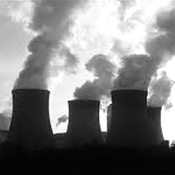Climate Resilience Means Avoiding Sources That Emit Carbon dioxide

One of the most controversial questions being asked in the electricity sector these days is whether we have a power grid that is resilient to the natural and manmade threats that it faces. Answering this question requires policymakers to evaluate the threats and determine whether the work of system planners and market designers will reduce the magnitude and duration of a disturbance in grid operations by spurring operational practices and investments in transmission, distribution, and generation assets.
But what if some of those very assets are among the causes of the disturbance? In other words, what if the resources powering the grid itself are contributing to, and exacerbating, the severe weather events that are interrupting electric service to customers for days or weeks on end?
As the effects of a changing climate have become more apparent, electric utilities have engaged in adaptation strategies to ensure that they are better prepared for severe weather events whose frequency and intensity will increase with climate change. For example, sea-level rise, one of the most readily observable climate impacts, is already having significant effects on the infrastructure of coastal utilities. Rising sea levels endanger power plants and other structures that rely on ocean water for cooling.
Furthermore, utility infrastructure, such as distribution lines to reach coastal residential and commercial locations, is susceptible to both long-term inundation as well as periodic tidal flooding and/or storm surge flooding. In response, many coastal utilities — as well as those with infrastructure on the coastline or within tidal basins — are looking to raise structures above current and projected sea levels.
Climate change is also intensifying weather-related extremes — in the summer creating higher overall and peak temperatures as well as longer and more frequent heat waves. Such events increase the need for electricity, yet extreme heat reduces transformer capacity. Conversely, as we on the East Coast saw again this winter, polar vortices can bring extreme cold, which can also stress the system in unexpected ways.
Finally, and most obviously, high-wind events damage transmission and distribution lines and poles, disrupting service until they can be repaired. State commissions are authorizing funds to harden the distribution network, acknowledging that events are not one-off occurrences, but rather, are an increasingly likely outcome of a changing climate. They are expecting utilities to bring the system back up just as quickly, despite the increasing intensity and frequency of severe weather.
Investing in system improvements is well worth the cost, given that 2017 was the most expensive year on record for severe weather and climate events, according to the World Meteorological Organization. A recent WMO report described how the very active North Atlantic hurricane season, major monsoon floods in the Indian subcontinent, and continuing severe drought in parts of east Africa contributed to this record-setting economic impact. The report estimates that the total disaster losses from weather- and climate-related events in 2017 was $320 billion, the largest annual total on record (after adjustment for inflation).
However, this “react” strategy only goes so far. It makes little sense to focus exclusively on adapting the grid infrastructure to this changing reality — instead, infrastructure investments should be designed to ensure that the system that provides electricity from coast to coast is contributing lower and lower amounts of the pollution that is accelerating and intensifying climate impacts.
A realistic and rational approach to identifying the components of a resilient system should incorporate the potential for this system to mitigate the risk it faces, and be responsive to the fact that generation sources that emit high levels of greenhouse gas pollution are not identical to generation sources that emit little to no climate pollution. In other words, planning a generation system that is resilient must include planning for a system that is both able to withstand interruptions and also does not contribute to interruptions by exacerbating climate change.
There is a real-world example facing the mid-Atlantic power system right now. Four nuclear power plants in Pennsylvania and Ohio have announced that they will retire in the next three years. Last year, those plants produced 40 terawatt hours of carbon-free power. When they retire, that generation will be replaced almost exclusively by fossil fuel-fired plants, resulting in over 20 million metric tons of additional carbon emissions annually, the equivalent of putting over 4 million cars on the road. Until we factor the emissions impact of our generation sources into our resilience planning, we are destined to stay in this never-ending cycle.
Climate resilience means avoiding sources that emit carbon dioxide.

